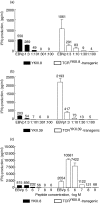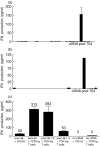T cell receptor-transgenic primary T cells as a tool for discovery of leukaemia-associated antigens
- PMID: 16367937
- PMCID: PMC1809573
- DOI: 10.1111/j.1365-2249.2005.02967.x
T cell receptor-transgenic primary T cells as a tool for discovery of leukaemia-associated antigens
Abstract
Identification of a broad array of leukaemia-associated antigens is a crucial step towards immunotherapy of haematological malignancies. However, it is frequently hampered by the decrease of proliferative potential and functional activity of T cell clones used for screening procedures. Transfer of the genes encoding the T cell receptor (TCR) alpha and beta chains of leukaemia-specific clones into primary T cells may help to circumvent this obstacle. In this study, transfer of two minor histocompatibility antigen (minor H antigen)-specific TCRs was performed and the feasibility of the use of TCR-transgenic T cells for identification of minor H antigens through cDNA library screening was investigated. We found that TCR-transgenic cells acquired the specificity of the original clones and matched their sensitivity. Moreover, the higher scale of cytokine-production by TCR-transgenic T cells permits the detection of either small amounts of antigen-positive cells or cells expressing low amounts of an antigen. When applied in equal numbers, TCR-transgenic T cells and the original T cell clones produced similar results in the screening of a cDNA library. However, the use of increased numbers of TCR-transgenic T cells allowed detection of minute amounts of antigen, barely discernible by the T cell clone. In conclusion, TCR-transfer generates a large amount of functional antigen-specific cells suitable for screening of cDNA expression libraries for identification of cognate antigens.
Figures




Similar articles
-
HLA class II restricted T-cell receptor gene transfer generates CD4+ T cells with helper activity as well as cytotoxic capacity.Gene Ther. 2005 Dec;12(23):1686-95. doi: 10.1038/sj.gt.3302586. Gene Ther. 2005. PMID: 16034453
-
Rebuilding human leukocyte antigen class II-restricted minor histocompatibility antigen specificity in recall antigen-specific T cells by adoptive T cell receptor transfer: implications for adoptive immunotherapy.Clin Cancer Res. 2007 Jul 1;13(13):4009-15. doi: 10.1158/1078-0432.CCR-07-0286. Clin Cancer Res. 2007. PMID: 17606735
-
Rapid re-expression of retrovirally introduced versus endogenous TCRs in engineered T cells after antigen-specific stimulation.J Immunother. 2011 Mar;34(2):165-74. doi: 10.1097/CJI.0b013e318206a10c. J Immunother. 2011. PMID: 21304404
-
T-cell receptor retrogenic mice: a rapid, flexible alternative to T-cell receptor transgenic mice.Immunology. 2012 Jul;136(3):265-72. doi: 10.1111/j.1365-2567.2012.03574.x. Immunology. 2012. PMID: 22348644 Free PMC article. Review.
-
Redirecting cytotoxic T lymphocyte responses with T-cell receptor transgenes.Expert Opin Biol Ther. 2002 Apr;2(4):353-60. doi: 10.1517/14712598.2.4.353. Expert Opin Biol Ther. 2002. PMID: 11955274 Review.
Cited by
-
Strategies for the identification of T cell-recognized tumor antigens in hematological malignancies for improved graft-versus-tumor responses after allogeneic blood and marrow transplantation.Biol Blood Marrow Transplant. 2015 Jun;21(6):1000-7. doi: 10.1016/j.bbmt.2014.11.001. Epub 2014 Nov 20. Biol Blood Marrow Transplant. 2015. PMID: 25459643 Free PMC article. Review.
-
Targeting cancers through TCR-peptide/MHC interactions.J Hematol Oncol. 2019 Dec 18;12(1):139. doi: 10.1186/s13045-019-0812-8. J Hematol Oncol. 2019. PMID: 31852498 Free PMC article. Review.
References
-
- Champlin R, Gale RP. Bone marrow transplantation: its biology and role as treatment for acute and chronic leukemias. Ann NY Acad Sci. 1987;511:447–58. - PubMed
-
- Antin JH. Graft-versus-leukemia: no longer an epiphenomenon. Blood. 1993;82:2273–7. - PubMed
-
- Spierings E, Wieles B, Goulmy E. Minor histocompatibility antigens − big in tumour therapy. Trends Immunol. 2004;25:56–60. - PubMed
MeSH terms
Substances
LinkOut - more resources
Full Text Sources
Other Literature Sources

